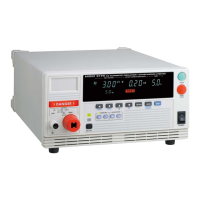2.4 Connecting the Test Lead
20
Connect the 9615 H.V. Test Lead to the Voltage Output Terminal on the front of
the instrument. When using Contact Check, connect to the Contact Check Ter-
minal on the back as well.
2.4 Connecting the Test Lead
• Before using the instrument, make sure that the insulation on the test
leads is undamaged and that no bare conductors are improperly
exposed. Using the instrument in such conditions could cause an elec-
tric shock, so contact your dealer or Hioki representative for replace-
ments. (Model 9615 H.V.TEST LEAD)
• To avoid shock and short circuits, turn off power before connecting test
leads.
• To avoid electric shock, make sure the test lead is securely connected
before starting a test, as a loose test lead can cause a hazard when a
voltage is output.
• Never touch the voltage output terminals, test lead, or the tested object
during a test (when is light up).
• Voltage may still remain on the voltage output terminal even after the test
has completed. Confirm that no more voltage is left on the voltage output
terminal when touching the voltage output terminals, test lead, or the
tested object.
• To avoid electric shock, make sure the power is switched off before con-
necting a ferrite or resistor to remove noise.
• Inaccuracy in measurement may occur during insulation-resistance test if the
instrument is put in a humid place so try to avoid doing so. If there is a possi-
bility of the test lead becoming too humid, protecting the test lead with desic-
cant is recommended. If the test lead touches other metals, leakages in
electric current may increase so be careful when coiling the test lead to avoid
touching other parts.
• Do not allow the test lead used for Contact Check (HIGH, LOW terminals) to
directly touch the test lead for the voltage output terminals (HIGH, LOW termi-
nals) as this may make detecting loose connection difficult.
• If the HIGH and LOW voltage output terminals short-circuit or a dielectric
breakdown occurs in the tested object during the test, noise will be generated
and such noise may lead to a malfunction of this instrument or of a nearby
electronic device. If this problem occurs, connect a ferrite core or a resistor to
the H. V. Test Lead (high voltage side). When using a resistor, choose one
appropriate for the power rating and withstand voltage. Also, be alert to any
drop in test voltage.

